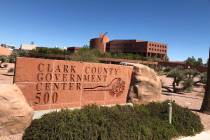Las Vegas is changing as it grows, census report finds
The U.S. Census Bureau on Thursday released five-year estimates documenting a multitude of trends in Clark County and other areas across the country.
The 2013-2017 American Community Survey contacted about 3.5 million households nationwide and produced data on social, economic, housing and demographic topics.
The numbers reveal how Southern Nevada has changed compared with the period from 2008 through 2012.
A top 30 metro area
The Las Vegas metropolitan area saw its population grow by more than 157,000 from the 2008-12 period to the 2013-17 period.
The increase made the area, which has the same boundaries as Clark County, the 30th-most populous metropolitan area in the U.S., passing Cleveland and Kansas City.
Las Vegas was passed by the Charlotte metropolitan area, which covers areas in both North Carolina and South Carolina.
Many new faces in Clark County came from California, according to data from the 2012-2016 American Community Survey. Estimates on county-to-county migration showed that nearly one-third of the 110,000 people who moved into Clark County in the past year had come from the Golden State. Los Angeles County was the origin of some 14,000 people.
It’s a long-standing trend that has influenced Nevada politics, said Robert Lang, an urban affairs expert and executive director of Brookings Mountain West at UNLV.
“About 10 percent of people who vote in Southern Nevada have a county of birth in Nevada, and 33 percent have a county of birth in California,” he said.
More Latino, less white, older
Latinos accounted for just about half the population increase in Clark County.
Meanwhile, the number of people who identified only as white fell by almost 37,000. It was the only race to decrease in number, and it means whites now make up less than two-thirds of the county’s population.
“You had an elderly white population (dying), and you didn’t receive enough in-migration to replace it,” Lang said.
He also noted that more interracial marriages are happening, meaning that a white parent will have children who identify as more than one race.
“Clark County is most like America is predicted to be in 2060,” he said. “We’re just ahead of the country in that regard. The U.S. is getting there.”
The county’s population is also getting older on average. The percentage of people aged 50 and older rose, while the opposite was true for people younger than that.
The median age is now almost 37. Lang attributed that to aging baby boomers.
Washoe surpasses Clark
Clark County’s median household income increased by less than $700 from the 2008-12 period to the 2013-17 period. That’s about seven times lower than the $4,600 increase that both Washoe County and the U.S. saw in that time.
Clark County’s sluggish growth is indicative of its tourism-dependent economy, said professor Stephen Miller, director of UNLV’s Center for Business and Economic Research.
“Leisure and hospitality, which is important in Southern Nevada, doesn’t tend to be high-paying,” he said.
Conversely, Northern Nevada has created jobs through the Tahoe Reno Industrial Center, home to Tesla’s Gigafactory.
“Washoe County has been more successful in diversifying their economy than we have in the south,” Miller said. “Faraday Future (in North Las Vegas) was supposed to be a big win for us, but when they left it was a big loss.”
Renting is more popular
Clark County’s housing inventory increased by close to 44,000 units from the 2008-12 period to the 2013-17 period.
For every 100 of the homes added, 95 were occupied by renters. The new five-year estimates show about 47 percent of all households in the county are renting, an increase of about 3 percentage points.
Vivek Sah, who oversees UNLV’s Lied Institute for Real Estate Studies, said several things are driving the trend.
First and foremost, local homes prices have soared in recent years. U.S. Nevada driver’s license data also show that the lion’s share of adults moving here are age 40 or younger, an age group that tends to rent rather than buy. Stricter lending regulations were also put in place after the Great Recession.
The housing trend could prove problematic if it continues, Sah said. Paying rent instead of a mortgage could hinder residents in the long run because they aren’t building an asset and creating wealth.
“A home line of equity could be used to fund the (college) education of your kids,” he said. “You can’t do that if you’ve never owned a home and you’re just renting.”
Contact Michael Scott Davidson at sdavidson@reviewjournal.com or 702-477-3861. Follow @davidsonlvrj on Twitter.





























